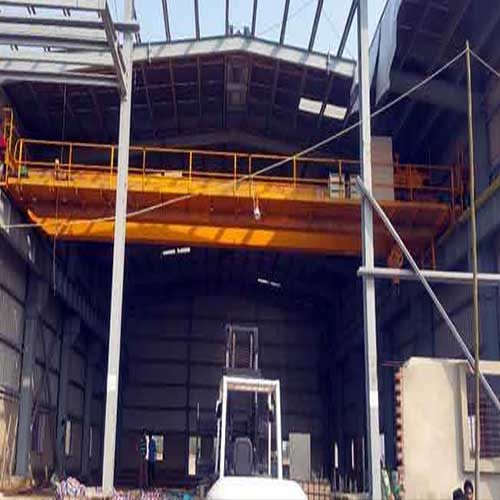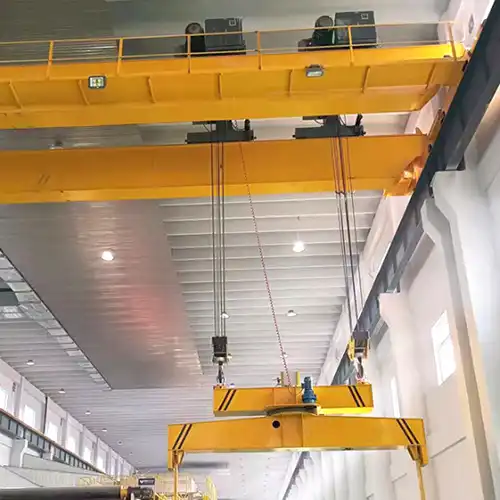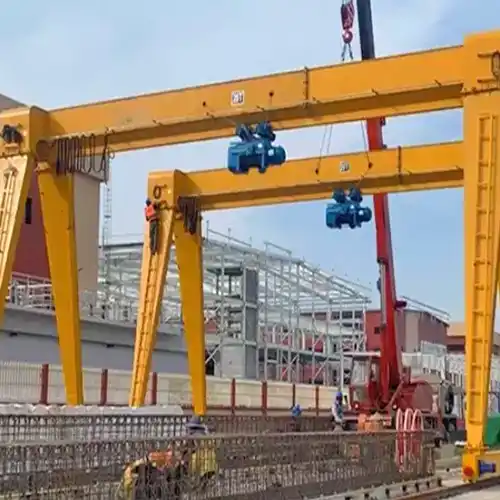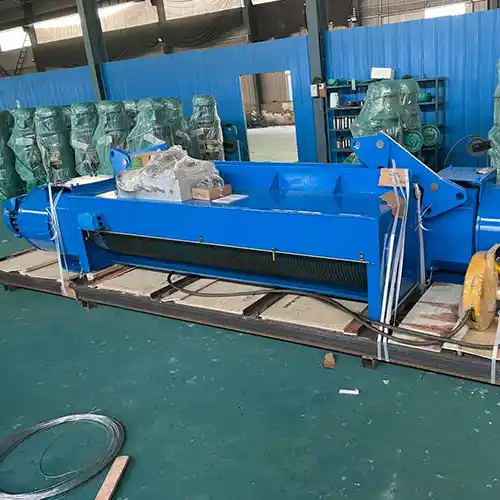20 ton Overhead Crane for Steel Coil Hoisting in Oil Tank Processing
Overhead crane for steel oil tank manufacturing and handling. Check 20 ton Overhead Crane for Steel Coil Handling in Oil Tank Processing in Bangladesh.
Category: Oil & Gas
Your Trusted Overhead Bridge Crane Manufacturer & Supplier
20 ton Overhead Crane for Steel Coil Hoisting in Oil Tank Processing
Overhead crane for steel oil tank manufacturing and handling. Check 20 ton Overhead Crane for Steel Coil Handling in Oil Tank Processing in Bangladesh.
Case Study: 20 ton Overhead Crane for Steel Coil Handling in the Oil Tank Processing Industry
The project focuses on the deployment of a specialized 20-ton double girder overhead crane within an oil tank processing facility in Bangladesh. This initiative aims to enhance the efficiency and reliability of the client's fuel production operations by addressing crucial steel coil handling requirements. The crane's tailored design and robust features specifically cater to the critical phase of steel coil handling, ensuring seamless operations within the oil tank manufacturing process. By providing a customized lifting solution, the project seeks to optimize productivity, minimize downtime, and bolster operational continuity in the client's manufacturing facility.
Client Background
The client, an esteemed fuel company based in Bangladesh, has been a significant player in the oil sector since its establishment in 1990. Renowned for its exceptional products, innovative approaches, and expertise in the field, this company has garnered global recognition as a leading supplier in the industry. Given its substantial influence in the country's economy, the efficiency and reliability of its production processes are paramount.
Lifting Requirements:
Within the fuel production operations, the processing of steel coil tanks stands as a pivotal procedure. Efficient handling of these coils directly impacts the overall performance and continuity of the production line. Recognizing the criticality of this process, the client sought a reliable lifting solution to streamline their operations and prevent potential disruptions.
Challenges Presented:
- Efficiency Demands: The coils' timely and efficient lifting was crucial to ensure seamless operations in the production line.
- Performance Optimization: Any compromise in lifting efficiency could lead to significant setbacks in the entire fuel production process.
- Equipment Reliability: The need for a robust and dependable overhead crane to handle the steel coil tanks without any compromise in safety or performance.
Crane Solution Provided:
As a leading material handling equipment manufacturer, our engineer proposed a tailored solution to address the client's lifting requirements effectively. Based on an in-depth assessment of the client's needs and factory conditions, the recommendation presented was a specialized 20 ton, 20-meter span double girder overhead crane.
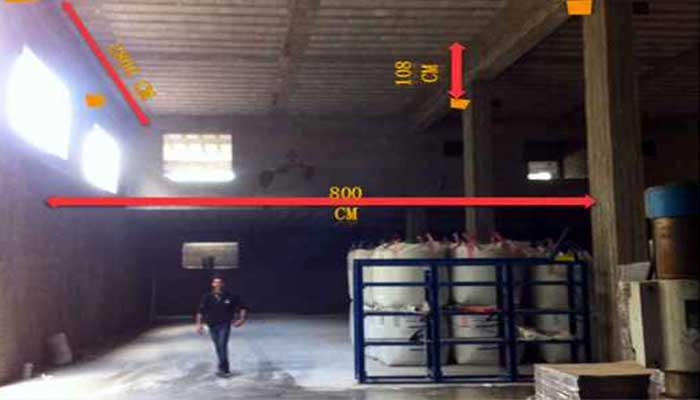
client's workshop

double girder overhead crane drawing for your reference
Key Features of the 20 Ton Double Girder Overhead Crane:
- Capacity: 20 tons, suitable for handling steel coil tanks efficiently.
- Double Girder Design: Ensures enhanced stability, strength, and durability, vital for heavy-duty lifting operations.
- 20-Meter Span: Adequate span to cover the required area within the production facility, offering versatility in handling tasks.
- Efficient Lifting Mechanism: Equipped with precision lifting mechanisms to ensure swift and secure handling of steel coil tanks.
- Safety Measures: Incorporates advanced safety features to mitigate risks during lifting operations, prioritizing personnel and asset safety.
- Customized Design: Tailored specifically to meet the client's lifting demands, optimizing performance without unnecessary expenditures.
Funtions of 20 Ton Overhead Cranes
- Steel Coil Handling: Facilitates the lifting, movement, and precise positioning of steel coils essential for oil tank manufacturing.
- Component Handling: Enables the safe and efficient handling of various components, aiding in the assembly and fabrication of oil tanks.
- Operational Versatility: Adaptable to different tasks and stages within the oil tank manufacturing process, contributing to seamless operations.
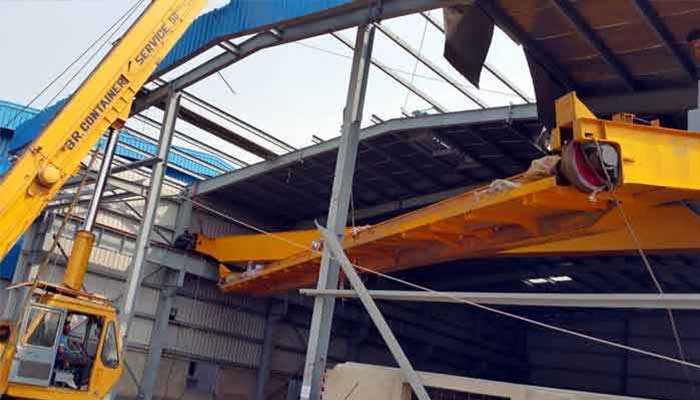
20 ton double girder overhead crane installation

20 ton bridge crane installation in Bangladesh
Benefits of 20 Ton Double Girder Crane for Material Handling
Upon the installation of the recommended 20 ton double girder overhead crane, the client experienced several positive outcomes:
- Enhanced Efficiency: The crane significantly improved the efficiency of steel coil handling, minimizing downtime and ensuring uninterrupted production flow.
- Operational Continuity: With a reliable lifting solution in place, the client achieved consistent performance within their fuel production line.
- Cost-Effectiveness: The tailored solution met the lifting requirements without incurring unnecessary expenses, maximizing the client's investment.
- Client Satisfaction: The client expressed satisfaction with the crane's performance, reliability, and its positive impact on their operations.
Our engineer 's customized approach in providing a specialized overhead crane solution tailored to the unique needs of the influential fuel company in Bangladesh underscored the company's commitment to delivering optimal lifting equipment for the oil industry. The successful implementation of the 20 ton double girder overhead crane showcased the effectiveness and reliability of the recommended solution, contributing significantly to the client's operational success in the oil tank processing industry.
Overview to Overhead Cranes in Oil Tank Processing and Handling
The oil tank manufacturing process encompasses the creation, assembly, and handling of various types of oil storage tanks used in the petroleum industry. These tanks serve a critical role in storing crude oil, refined petroleum products, and other liquid substances. Oil tank manufacturing involves precision engineering and fabrication to meet stringent quality and safety standards.
Handling and managing oil tanks throughout their lifecycle, from fabrication to installation and maintenance, necessitate specialized equipment and procedures. This includes the transportation of raw materials, components, and the final tanks within manufacturing plants, storage facilities, and oil refineries.
Overhead cranes play an indispensable role in the oil tank processing industry. These heavy-duty lifting machines are pivotal in the movement, lifting, and precise positioning of materials and components involved in oil tank manufacturing. Their ability to efficiently handle heavy loads, such as steel coils used in tank fabrication, and maneuver finished tanks within production facilities is crucial to maintaining operational efficiency.
These cranes contribute significantly to streamlining operations, reducing manual handling, and enhancing productivity. Their adaptability in handling diverse loads and their ability to cover extensive areas within manufacturing plants make them indispensable in oil tank processing.
Efficient material handling is paramount in oil tank processing due to the size, weight, and delicacy of the components involved. Timely and precise handling of materials, especially steel coils used in constructing oil tanks, directly impacts the manufacturing timeline and overall operational efficiency.
Overhead cranes, with their lifting capabilities and maneuverability, ensure a streamlined material handling process. By optimizing material flow and minimizing downtime, these cranes contribute to maintaining a continuous production cycle, thereby enhancing the overall effectiveness of oil tank processing operations.
Types of Overhead Cranes Used in Oil Tank Processing
Overhead cranes used in oil tank processing and oil tank handling are specialized equipment designed to facilitate the lifting, movement, and manipulation of heavy components, equipment, or materials within oil refineries, terminals, and storage facilities. These cranes play a crucial role in ensuring efficient and safe operations in the oil industry. Here are some typical types of overhead cranes used for these purposes:
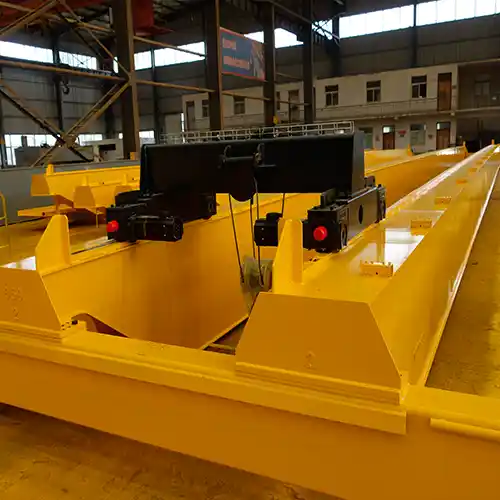
Double Girder Overhead Cranes:
Double Girder Overhead Cranes:These cranes are robust and commonly used in heavy-duty applications within oil tank processing facilities. They offer high lifting capacities and are suitable for handling large and heavy equipment or materials. Double girder cranes provide increased stability and can cover larger spans, making them ideal for lifting heavy components or maneuvering items within oil tank storage areas.
Features:
Two horizontal girders providing robustness and stability.
Suitable for heavy-duty lifting in oil tank processing.
Accommodates higher lifting capacities compared to single girder cranes.
Functions:
Efficient handling of heavier loads, including steel coils and larger oil tank components.
Ideal for covering larger spans and facilitating precise movements during oil tank assembly.
Objects Handling:
Heavy steel coils, large oil tank components, machinery parts, and equipment used in oil tank fabrication.
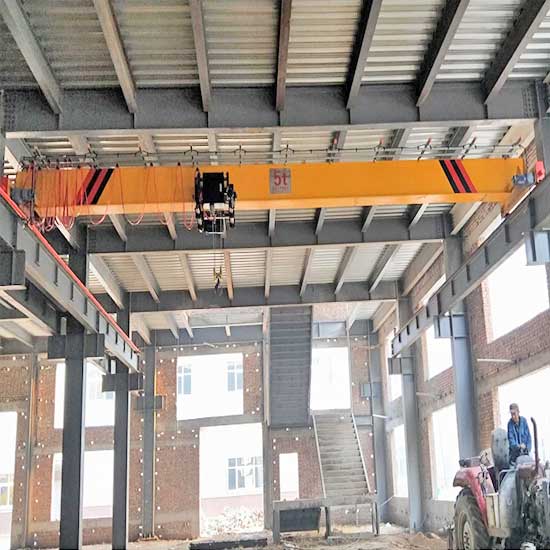
Single Girder Overhead Cranes:
Single Girder Overhead Cranes:While they may have slightly lower lifting capacities compared to double girder cranes, single girder overhead cranes are versatile and cost-effective. They are used in situations where moderate lifting requirements exist, such as moving smaller oil tank components or handling maintenance tasks.
Features:
Utilizes a single horizontal girder, making it lighter and more cost-effective.
Suitable for moderate lifting tasks and compact spaces.
Offers flexibility in handling various loads.
Functions:
Efficiently handles lighter loads and smaller components within oil tank manufacturing.
Maneuverability in confined areas, aiding maintenance and specific handling tasks.
Objects Handling:
Smaller steel components, lighter machinery parts, and materials used in the assembly of oil tanks.
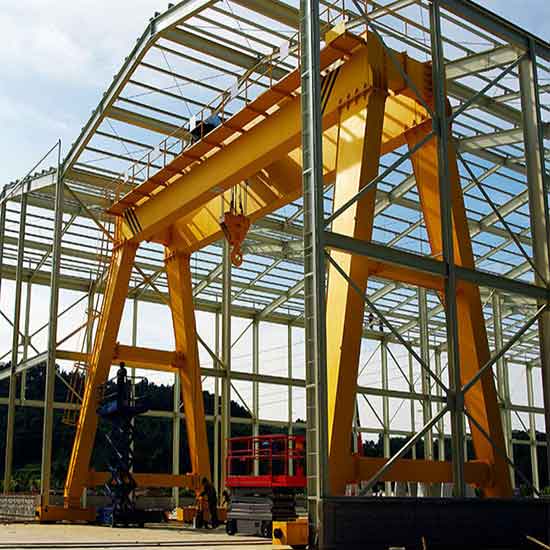
Gantry Cranes
Gantry Cranes:Gantry cranes are similar to overhead cranes but are supported on legs or runways at ground level, allowing for greater mobility. They are useful in outdoor oil tank storage yards or facilities where maneuvering around obstacles or varying terrain is necessary.
Features:
Supported on legs or runways at ground level, offering mobility and adaptability.
Ideal for outdoor use or facilities with uneven terrain.
Provides lifting and movement capabilities.
Functions:
Handling materials in outdoor oil tank storage areas.
Supporting assembly or maintenance tasks in spaces without overhead structures.
Objects Handling:
Varied materials used in outdoor storage, larger oil tank components, and machinery parts.
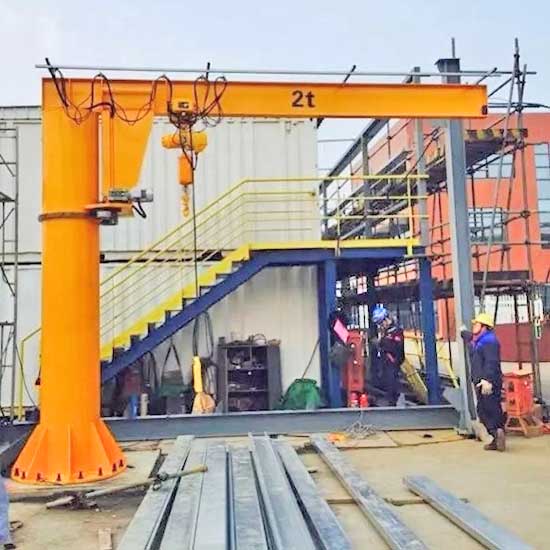
Jib Cranes:These cranes have a pivoting arm (jib) that allows for precise lifting and movement in a specific area. Jib cranes are suitable for localized tasks, such as transferring materials to and from specific points within an oil tank processing area.
Features:
Utilizes a pivoting arm (jib) for localized lifting and movement.
Offers precision handling in specific areas within the oil tank processing facility.
Ideal for targeted material transfer or placement.
Functions:
Handling tasks requiring precise and localized movements.
Loading or unloading materials at specific points in the oil tank manufacturing area.
Objects Handling:
Smaller components, maintenance tools, and materials requiring precise positioning within the oil tank facility.
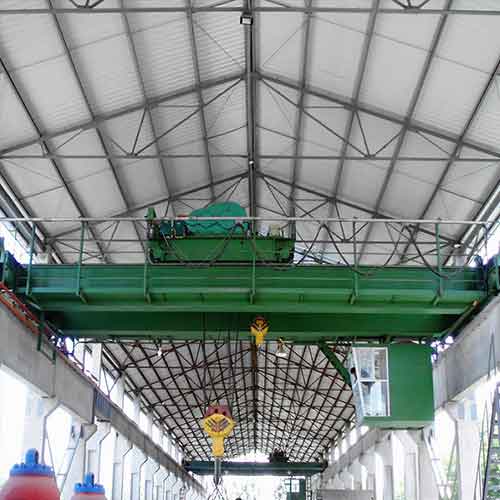
Explosion-Proof Cranes:In potentially hazardous environments such as oil refineries, explosion-proof overhead cranes are essential. They are designed to mitigate the risk of ignition by preventing the formation of sparks or heat that could trigger explosions in volatile atmospheres where flammable gases or liquids are present.
Features:
Specifically designed for hazardous environments with flammable materials or gases.
Equipped with safety features to prevent ignition or spark generation.
Functions:
Ensures safe lifting operations in potentially explosive atmospheres within oil tank processing facilities.
Prevents risks associated with fire or explosions during material handling.
Objects Handling:
Varied materials and components used in oil tank processing while maintaining safety in hazardous environments.
Each type of overhead crane in the oil tank processing industry possesses unique features, functions, and capabilities, catering to specific lifting needs and ensuring efficient material handling throughout the manufacturing and maintenance of oil tanks.
Specialized Overhead Crane of Steel Oil Tank Manufacturing and Handling
In addition to steel coil handling cranes, several other types of specialized overhead cranes are used in oil tank manufacturing and handling to facilitate various tasks and operations. Some of these specialized overhead cranes include:
- Coil handling cranes -A coil handling crane is a specialized overhead crane designed specifically for lifting, transporting, and handling steel coils within various industries, including oil tank manufacturing. These cranes are crucial for efficient and safe movement of heavy and often cumbersome steel coils used in the fabrication and assembly of oil tanks.
- Assembly Cranes: Specifically designed for the assembly process, these cranes assist in lifting and positioning large components or sections of oil tanks during the construction phase. They are crucial for precise alignment and joining of tank segments.
- Maintenance Cranes: Dedicated to maintenance and repair tasks, these cranes are designed to access and handle equipment or components requiring servicing within the oil tank manufacturing facility. They provide safe and efficient lifting for maintenance operations.
- Storage Yard Cranes: Used in storage yards or warehouses, these cranes aid in the organization and movement of finished or semi-finished oil tank components. They facilitate the stacking, retrieval, and transport of tanks or parts within the storage area.
- Container Handling Cranes: Facilities involved in transporting or handling oil tank containers utilize specialized container handling cranes. These cranes efficiently load, unload, and position containers, optimizing the logistics and transportation of tanks.
- Telescopic Cranes: Telescopic cranes offer versatility in reach and lifting capabilities. They can extend or retract their boom sections, allowing for flexibility in handling materials or components of varying sizes and weights in oil tank manufacturing.
- Articulating Cranes: These cranes feature a jointed arm, enabling them to reach around obstacles or into confined spaces within an oil tank manufacturing facility. They are useful for precise material handling in constrained areas.
- Rail-Mounted Cranes: Rail-mounted cranes run on rails, offering mobility and flexibility in material handling across a manufacturing facility. They are particularly useful for transporting heavy components or finished oil tanks over long distances.
- Automated Guided Vehicle (AGV) Cranes: AGV cranes operate autonomously and are guided by pre-defined paths or systems within the manufacturing facility. They are employed for automated and repetitive material transportation tasks, optimizing efficiency in material flow.
These specialized overhead crane types cater to specific needs and operations within oil tank manufacturing and handling facilities. They are selected based on the nature of tasks, space constraints, safety requirements, and the overall layout of the manufacturing facility to ensure efficient and safe handling of materials and components throughout the oil tank manufacturing process.
Overhead Crane Selection Considerations for Oil Tank Handling
Determining Load Capacities for Steel Coil Handling
- Understanding Load Specifications: Analyzing the weight, dimensions, and structural characteristics of steel coils used in oil tank fabrication.
- Calculating Load Variations: Considering variations in coil weight, size, and the number of coils to determine average and maximum load capacities.
- Accounting for Handling Dynamics: Factoring in dynamic loading aspects during lifting, movement, and placement of steel coils to ensure crane capabilities align with operational requirements.
Choosing Suitable Crane Capacities for Finished Oil Tank Handling
- Assessing Tank Weight and Dimensions: Evaluating the weight, size, and specifications of finished oil tanks to determine appropriate crane lifting capacities.
- Considering Maneuverability Requirements: Identifying the need for precise movements and positioning of finished oil tanks within the manufacturing facility or storage area.
- Adapting Crane Capacities: Selecting overhead crane capacities that align with the weight range of finished oil tanks, ensuring safe and efficient handling during assembly, transportation, or storage.
Custom Solutions for Unique Lifting Requirements
- Identifying Specialized Lifting Needs: Recognizing specific or non-standard lifting requirements unique to the oil tank processing environment.
- Engineering Tailored Solutions: Collaborating with crane manufacturers or engineering teams to develop customized crane configurations or attachments for handling specialized loads.
- Testing and Validation: Conducting thorough testing and validation procedures to ensure the effectiveness and safety of custom solutions in meeting unique lifting demands.
Safety Features and Compliance in Hazardous Environments
- Hazardous Area Assessment: Identifying zones within the oil tank processing facility classified as hazardous or potentially explosive environments.
- Explosion-Proof Crane Requirements: Ensuring overhead cranes deployed in hazardous areas comply with explosion-proof specifications and safety standards.
- Incorporating Safety Features: Implementing safety features such as spark prevention, overload protection, emergency stop systems, and compliance with industry safety regulations.
- Training and Operational Protocols: Providing comprehensive training to crane operators and personnel on safety protocols, emergency procedures, and compliance with hazardous area regulations.
This section covers the critical considerations when selecting overhead cranes for various stages of oil tank handling, encompassing load capacities, customized solutions, and safety features necessary for efficient and safe operations in oil tank processing environments.
Enhancing Efficiency in Oil Tank Manufacturing with Overhead Cranes
An oil tank, also known as an oil storage tank or petroleum tank, is a container specifically designed for storing various types of oil-based products, including crude oil, refined petroleum products like gasoline, diesel, jet fuel, and other liquid substances used in the oil and gas industry. These tanks are integral components of oil refineries, terminals, depots, and industrial facilities where the storage and distribution of oil-based products occur.
Oil tank processing involves a series of procedures related to the handling, storage, and management of oil within these storage tanks. This includes activities such as filling the tanks with crude oil or refined products, monitoring and controlling temperature and pressure, ensuring safety measures to prevent leaks or spills, maintaining the tanks, and ultimately transferring the oil to various distribution channels.
Typical Sizes and Dimensions of Oil Tanks:
Oil tanks come in various sizes and dimensions, depending on their specific purpose, location, and capacity requirements. Typical sizes can vary widely, from small residential tanks to massive industrial storage tanks. Here are some general insights:
- Residential Oil Tanks:These are smaller tanks typically found in homes for heating oil storage. They can range from around 250 gallons (946 liters) to 1000 gallons (3785 liters), with dimensions varying based on the tank's shape and design.
- Commercial and Industrial Oil Tanks:These are larger tanks used in industrial settings or fuel distribution centers. Their sizes can vary significantly and may range from a few thousand gallons to several hundred thousand gallons or more. The dimensions and shapes of these tanks depend on factors like capacity, space availability, and specific operational requirements.
The weight of an oil tank largely depends on its size, material, and the type of oil it is designed to store. Smaller residential tanks may weigh a few hundred pounds, while larger industrial tanks made of steel or other heavy-duty materials can weigh several tons when empty.
It's essential to note that the sizes, dimensions, and weights of oil tanks can vary significantly based on specific industry requirements, safety standards, regulations, and the intended use of the tank—whether for temporary storage, transportation, or long-term stationary storage within an oil refinery or distribution facility. Regulations and standards governing the design, construction, and operation of these tanks also impact their sizes and specifications to ensure safety and environmental compliance.
Optimizing Production Flow: How Overhead Cranes Improve Steel Coil Handling in Oil Tank Processing
Steel coil handling is a critical aspect of oil tank manufacturing, and the utilization of overhead cranes significantly enhances this process. The efficiency and precision of handling steel coils impact the overall production flow within oil tank processing facilities.
- Streamlined Material Handling:Overhead cranes play a pivotal role in streamlining material handling operations. Their robust lifting capabilities and versatility allow for the efficient movement of steel coils within the manufacturing environment. By seamlessly transporting coils from one production station to another, these cranes considerably reduce handling time and enhance the overall workflow efficiency in oil tank fabrication.
- Precise Load Control:Advanced crane systems are equipped with sophisticated controls and lifting mechanisms, ensuring precise handling of steel coils. These features enable operators to maneuver coils with accuracy, placing them precisely in designated positions during the manufacturing process. Such precise load control minimizes errors, improves placement accuracy, and ultimately reduces the risk of material damage, ensuring higher product quality.
- Reduced Material Waste:One of the significant advantages of overhead cranes in steel coil handling is their contribution to minimizing material waste. Mishandling or damage to steel coils can result in substantial wastage, affecting both production timelines and costs. By employing overhead cranes with their precise load control and careful handling capabilities, the risk of damage is significantly mitigated. This reduction in material waste not only improves cost-effectiveness but also promotes sustainable manufacturing practices within the oil tank processing industry.
In conclusion, the utilization of overhead cranes in handling steel coils is instrumental in optimizing the production flow in oil tank manufacturing. These cranes facilitate streamlined material handling, provide precise load control, and effectively contribute to reducing material waste, ensuring efficient and cost-effective operations within oil tank processing facilities.
Improving Steel Coil Handling Efficiency
A coil handling crane is a specialized overhead crane designed specifically for lifting, transporting, and handling steel coils within various industries, including oil tank manufacturing. These cranes are crucial for efficient and safe movement of heavy and often cumbersome steel coils used in the fabrication and assembly of oil tanks.
Features of Coil Handling Cranes:
- High Load Capacity:Coil handling cranes are designed to handle substantial loads, as steel coils can be extremely heavy. They are equipped with mechanisms capable of lifting and moving coils of varying weights and sizes.
- Customized Attachments:These cranes often feature specialized attachments such as C-hooks or coil lifting clamps that securely grip the steel coils during lifting and transportation, ensuring stability and safety.
- Precision Control Systems:To ensure accurate and controlled movements, coil handling cranes are equipped with advanced control systems. These systems enable operators to lift, position, and lower steel coils with precision, minimizing the risk of damage.
- Safety Features:Safety is paramount when handling heavy loads. These cranes are equipped with safety devices and mechanisms to prevent accidents, such as overload protection systems, emergency stop buttons, and anti-sway technology.
- Flexibility and Maneuverability:Coil handling cranes are designed to maneuver in tight spaces and handle coils in various orientations, allowing for efficient movement and placement within the manufacturing facility.
- Adaptability to Different Coil Sizes:They can accommodate different sizes and diameters of steel coils commonly used in oil tank manufacturing, offering versatility in handling various coil specifications.
- Customizable Configurations:Depending on the specific requirements of the manufacturing facility, coil handling cranes can be customized in terms of lifting capacity, span, and lifting height to suit the operational needs.
Applications in Oil Tank Manufacturing:
In the oil tank manufacturing, coil handling cranes are employed for tasks such as:
- Lifting and transporting steel coils used for fabricating tank components.
- Moving coils to various stages of the manufacturing process, including cutting, forming, and welding.
- Precisely positioning steel coils for assembly onto oil tank structures.
- Loading and unloading coils from transportation vehicles for storage or processing.
Overall, coil handling cranes play a critical role in the efficient and safe handling of steel coils, ensuring a smooth manufacturing process in the construction of oil tanks. Their specialized design and capabilities are tailored to meet the specific demands of handling heavy coils in various stages of oil tank fabrication.
Exploring Customized Overhead Crane Solutions for Varied Oil Tank Manufacturing Processes
The diverse and specialized requirements encountered across different phases of oil tank manufacturing necessitate customized solutions in the form of overhead cranes. These tailored crane designs cater to specific handling needs, contributing significantly to the efficiency and effectiveness of the manufacturing processes.
Tailored Design Considerations:
Custom-designed overhead cranes play a pivotal role in accommodating the diverse and specialized handling needs encountered in different phases of oil tank manufacturing. These cranes are engineered with meticulous consideration of the specific requirements at each stage, ensuring optimal performance and seamless integration into the manufacturing workflow.
- Specific Requirements Analysis: Before the conceptualization and design phase, in-depth analysis and understanding of the specific handling requirements at each stage of oil tank manufacturing is conducted. This analysis encompasses factors such as load types, sizes, weight capacities, space limitations, and safety considerations.
- Precision Engineering for Each Phase: Tailored design considerations involve engineering cranes with meticulous attention to detail, ensuring they are purpose-built for their intended tasks in different phases of oil tank manufacturing. From material procurement to assembly, each component and feature is optimized for its specific function.
- Optimal Performance Integration: Every aspect of the crane's design, from structural components to lifting mechanisms and control systems, is optimized to ensure optimal performance within the given operational context. This includes considering factors like lifting speeds, precision controls, safety features, and adaptability to varying loads.
- Seamless Workflow Integration: Tailored design extends beyond just the crane's functionality. It also involves ensuring that the crane's operation seamlessly integrates into the overall manufacturing workflow. Cranes are strategically positioned and engineered to facilitate smooth material flow without hindering other operational processes.
- Compliance and Safety Standards: Design considerations also prioritize compliance with industry standards and safety regulations. Ensuring that the crane meets or exceeds safety protocols is paramount in the design phase, guaranteeing a safe working environment and adherence to legal requirements.
- Continuous Improvement and Adaptability: Tailored design doesn't end with the completion of the crane. It includes provisions for adaptability and future improvements. Components and features are designed with modularity and flexibility, enabling adjustments or upgrades to accommodate changing manufacturing needs.
Tailored design considerations are essential pillars in the creation of custom-designed overhead cranes for oil tank manufacturing. They ensure that these cranes are not just equipment but integral solutions that harmonize with the unique requirements of each stage in the manufacturing process, ultimately contributing to enhanced productivity, efficiency, and safety.
Collaborative Efforts for Bespoke Crane Solutions in Oil Tank Manufacturing
The collaboration between crane manufacturers and clients in the oil tank manufacturing industry is instrumental in creating customized crane solutions that precisely cater to the unique challenges faced within the operational environment. This collaboration involves a comprehensive and iterative process that integrates the expertise of both parties to deliver tailored crane solutions.
- Understanding Specific Operational Challenges: Crane manufacturers engage in in-depth discussions and consultations with clients to comprehensively understand the specific challenges encountered during oil tank manufacturing. These discussions encompass various aspects, including load capacities, spatial constraints, safety prerequisites, and any other distinctive handling challenges faced within the facility.
- Analyzing Operational Requirements: Through meticulous analysis and assessments, manufacturers gain insights into the exact operational requirements of the facility. This involves evaluating the types of loads to be handled, the frequency of crane usage, the spatial layout of the facility, and any constraints or limitations affecting crane deployment.
- Tailoring Crane Solutions to Address Challenges: Based on the gathered information and analyses, crane manufacturers collaborate with clients to devise bespoke solutions. These solutions are specifically engineered to address the identified challenges, ensuring that the cranes are optimized to meet the operational demands of the oil tank manufacturing facility.
- Iterative Design and Feedback Loops: The collaboration involves an iterative process where initial designs are proposed, and feedback is sought from the client. This iterative loop continues until the final crane solution aligns perfectly with the client's requirements, incorporating necessary modifications or adjustments based on the feedback received.
- Emphasis on Alignment and Integration: Throughout the collaboration, the primary focus remains on ensuring that the crane solutions seamlessly align with the operational workflow of the facility. This integration ensures that the cranes not only fulfill the handling needs but also contribute positively to the overall efficiency and productivity of the oil tank manufacturing processes.
- Final Validation and Implementation: Once the bespoke crane solutions are refined and approved, the final designs undergo validation processes to ensure they meet safety standards and compliance regulations. Upon validation, the cranes are implemented within the facility, with manufacturer support for installation, testing, and training of personnel.
The collaborative efforts between crane manufacturers and clients serve as the cornerstone for developing tailored crane solutions in oil tank manufacturing. This collaborative approach ensures that the resultant crane solutions precisely address the unique challenges of the facility, leading to enhanced operational efficiency, safety, and productivity.
Integration of Innovative Technologies in Customized Crane Designs for Oil Tank Manufacturing
Custom-designed cranes for oil tank manufacturing are not just conventional lifting equipment; they are sophisticated solutions that amalgamate innovative technologies to precisely address the operational demands within the industry. These technologies are strategically integrated into the crane designs, enhancing adaptability, efficiency, and overall performance in the manufacturing processes.
- Advanced Control Systems: Customized crane designs incorporate state-of-the-art control systems that offer precise and responsive handling. These systems enable operators to have granular control over crane movements, allowing for accurate positioning of materials during the various stages of oil tank manufacturing.
- Automation for Streamlined Operations: Automation features play a pivotal role in enhancing efficiency. Customized cranes may include automated functionalities for tasks such as load detection, route optimization, and automated lifting sequences. This automation streamlines operations, reduces manual intervention, and accelerates the production flow.
- Smart Lifting Features: Innovative smart lifting features, including sensors and monitoring systems, are integrated into the crane designs. These features enable real-time monitoring of load conditions, ensuring safe lifting operations, and providing data for predictive maintenance, ultimately improving safety and reliability.
- Adaptive and Flexible Functionalities: Customized cranes are engineered with adaptive functionalities to cater to the dynamic nature of oil tank manufacturing processes. They possess the ability to adjust lifting capacities, speed, and movements based on changing operational requirements, ensuring flexibility and adaptability.
- Precision and Safety Technologies: Cutting-edge technologies focused on precision and safety are incorporated into the crane designs. These may include anti-sway systems, collision avoidance sensors, and overload protection mechanisms. Such features mitigate risks, prevent accidents, and safeguard both equipment and personnel.
- Data Integration for Process Optimization: Customized cranes often feature data integration capabilities. They can collect and analyze operational data, providing insights for process optimization. This data-driven approach aids in identifying bottlenecks, enhancing workflows, and improving overall manufacturing efficiency.
- Remote Monitoring and Control: Some custom crane solutions may include remote monitoring and control functionalities. This enables operators to monitor crane operations remotely, providing flexibility in managing manufacturing processes and ensuring continuous operations.
In summary, customized crane designs for oil tank manufacturing leverage a spectrum of innovative technologies. These technologies are meticulously selected and integrated to enhance adaptability, efficiency, safety, and precision within the manufacturing processes, contributing significantly to optimized workflows and improved productivity.
Adaptable Crane Configurations for Oil Tank Manufacturing
Adaptable crane configurations are integral components in the arsenal of tools utilized within oil tank manufacturing facilities. These configurations are purposefully designed to exhibit flexibility, versatility, and adaptability, catering to the varied stages and multifaceted requirements encountered in the oil tank manufacturing process.
- Modularity with Modular Components: Adaptable crane designs incorporate modular components that offer a high degree of customization and scalability. These modular components, such as booms, trolleys, and hooks, can be easily interchanged or replaced, facilitating swift modifications tailored to specific operational needs.
- Interchangeable Attachments and Tooling Options: Crane configurations feature the provision for interchangeable attachments and diverse tooling options. This adaptability allows the cranes to perform multiple tasks efficiently, from lifting and transporting materials to specialized functions like clamping, gripping, or rotating loads, ensuring versatility across various phases of oil tank manufacturing.
- Adjustable Functionalities and Settings: Adaptable crane configurations are equipped with adjustable functionalities and settings. These adjustable parameters might include lifting capacities, speed adjustments, and range modifications, allowing operators to fine-tune crane operations to suit the specific requirements of each task within the oil tank manufacturing process.
- Seamless Integration for Diverse Operations: These crane configurations seamlessly integrate into diverse operational scenarios within the manufacturing facility. Whether it's lifting heavy steel coils during fabrication, precise positioning of tank components during assembly, or the transportation of finished tanks, adaptable crane configurations ensure optimal performance across various operations.
- Flexibility in Handling Varied Loads: The flexibility offered by adaptable crane configurations extends to handling varied loads encountered throughout oil tank manufacturing. They are designed to handle different load sizes, weights, and shapes with precision and ease, ensuring efficiency regardless of the materials being handled.
- Support for Evolving Workflows: As oil tank manufacturing processes evolve, adaptable crane configurations support these changes. They facilitate adjustments in workflows, accommodate process modifications, and seamlessly integrate into the evolving operational requirements, ensuring continuous optimization of manufacturing processes.
- Enhanced Efficiency and Productivity: By offering adaptability and versatility, these crane configurations contribute significantly to enhancing efficiency and productivity within oil tank manufacturing facilities. They minimize downtime associated with reconfiguration, enable swift task-switching, and optimize resource utilization.
In essence, adaptable crane configurations are meticulously designed to offer a versatile, flexible, and adaptable solution for the dynamic requirements encountered in oil tank manufacturing. They are essential assets that ensure optimal performance, efficiency, and adaptability across the diverse operational landscape of the manufacturing facility.
Customized Solutions and Adaptability of Overhead Cranes
Tailored Crane Designs to Meet Specific Oil Tank Handling Needs
- Understanding Unique Requirements: Identifying specific lifting and handling needs within oil tank processing, such as non-standard loads or specialized tasks.
- Collaborative Engineering Solutions: Exploring collaboration between manufacturers and clients to design and develop bespoke crane solutions catering to specific needs.
- Performance Optimization and Custom Features: Detailing how customized crane designs optimize performance by integrating specialized features aligned with oil tank handling requirements.
Adaptability of Overhead Cranes to Varied Oil Tank Manufacturing Processes
- Handling Diverse Load Types: Discussing the adaptability of overhead cranes to handle varying materials, sizes, and weights encountered in different stages of oil tank manufacturing.
- Scalability and Configuration Changes: Highlighting how crane systems can be scaled or reconfigured to accommodate changes in production demands or manufacturing processes.
- Integration with Workflow Enhancements: Exploring how adaptable crane systems align with evolving workflows and process enhancements within oil tank manufacturing.
Flexibility in Crane Configurations for Diverse Handling Requirements
- Modularity in Crane Components: Explaining the modularity of crane components allowing for adjustments or reconfigurations based on evolving handling requirements.
- Attachment and Tooling Flexibility: Detailing how overhead cranes can accommodate various attachments and tooling options for different handling tasks.
- Multi-Functional Crane Configurations: Discussing the versatility of cranes that can perform multiple functions or tasks within the oil tank manufacturing facility.
This section delves into the adaptability and customization potential of overhead crane systems, emphasizing their capability to be tailored to unique requirements, adapt to changing manufacturing processes, and offer flexible configurations to meet diverse handling needs in oil tank processing.
Main Projects
Related Products

Supplied three grab bucket crane kits to Indonesia, enhancing garbage handling efficiency with high load capacity and reliable performance.
Free consultation to Confirm Parameters & Specifications and Get
Latest Crane Price & Crane Rate.
- Types of overhead cranes : _______?
- Optional: Overhead travelling crane, goliath gantry crane,Slewing jib crane, Single girder or double girder crane,small portable crane or kbk crane, etc.
- Capacity of overhead crane: _______?
- Optional: 0.25ton, 0.5 ton, 1 ton, 2 ton, 3ton, 5 ton, 10 ton,15ton, 20ton, 25 ton, 30ton,35ton, up to 550ton, etc.
- Crane span & lifting height : _______?
- Crane travelling length : _____?
- Control of overhead crane:_______?
- Optional: pendant/ remote/cabin control
- Voltage supply of overhead crane:_____?
- Eg,: 380V50/60HZ,3Phase or others,etc.
- Application/usage of crane:_______?
- Eg,: Steel mill, ,injection mold, cement,stone, concrete,granite, general manufacturing, etc.
Just leave a message via the contact form and our hoist and crane engineer will contact you with in 24working hours.
Get In Touch
